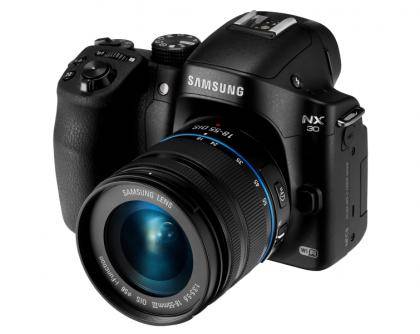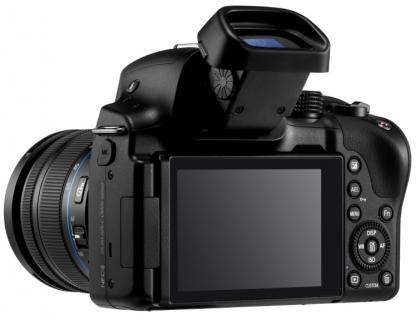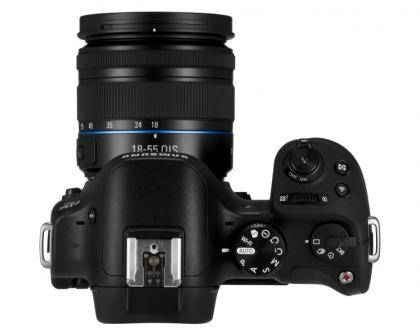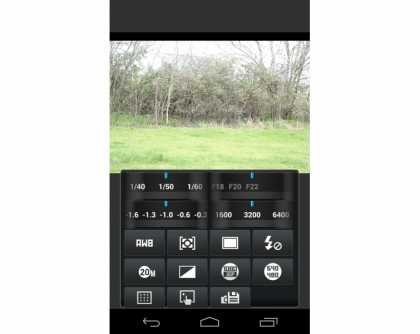The NX30 is the latest flagship model in Samsung's NX series. Whereas other NX models look like compact cameras, this one is distinctly SLR-shaped. Its viewfinder and pop-up flash are housed in a hump above the lens, and there's a substantial handgrip. It also uses the same APS-C sensor size as consumer SLRs. The net result is a camera that's not significantly smaller than entry-level SLRs such as the Canon EOS 100D . It's actually a few grams heavier than the 100D.
This might seem to be at odds with the CSC concept, where one of the main advantages is smaller, lighter designs than SLRs. That's not the only thing CSCs have to offer, though. The NX30's more traditional design means it can bring together the best of SLR and CSC technology.

This is without doubt our favourite CSC for ergonomics. The handgrip and thumb rest are superbly contoured for a snug fit, even in large hands. It's a world away from the slim protrusions on other premium CSCs such as the Panasonic GX7 and Fujifilm X-E2 . It's also more comfortable than the Panasonic GH3 , which is probably the NX30's closest rival with its similar SLR-inspired design. It's disappointing that the large handgrip hasn't provided room for a side-mounted card slot; instead, it's located in the battery compartment. Still, there's a fair amount distance from the compartment door to the tripod thread, so it might still be possible to remove a card while the camera is mounted on a tripod.

The electronic viewfinder (EVF) extends to give 36mm clearance from the back of the camera. It also tilts upwards, which is handy when shooting from a low camera position. There's an eye-level sensor to detect when the EVF is being used, but it's a little slow to respond when switching between the LCD and EVF. When the EVF wasn't extended and we quickly raised the camera to eye level, we managed to move the autofocus point with a nose prod to the touchscreen. The EVF image is pin sharp with its 1,024x768 resolution, but sadly it's quite a bit smaller than the EVFs on rival CSCs.
The controls are up to the same high standards as the ergonomics. The command dial and rear wheel provide direct access to shutter speed and aperture in manual exposure mode. Pressing the iFn button on the lens temporarily reassigns the focus ring to ISO speed, exposure compensation, white balance and a range of other functions. The 3in touchscreen makes it quick to move the autofocus area or enable the tracking focus mode. That's not so practical when using the EVF, but it's pretty quick to move the autofocus area using the navigation pad, too. There's also an option to adjust the size of the area using the command dial. With a drive mode dial and various other single-function buttons, there's very little reason to visit the menus. There's even a depth-of-field preview button on the front – a common feature among higher-end SLRs but rare for a CSC.

There is room for improvement in the controls, though. The quick-access menu (via the Fn button) brings up a largely duplicated set of controls – exposure compensation, ISO speed, white balance and so on – leaving various other functions such as JPEG/RAW settings, HDR mode and Auto ISO customisation buried in the main menu. Because the menu uses scrolling lists rather than discrete pages, we found it hard to remember where specific functions were located. Another concern is that the AF/MF switch on the lens is quite loose. On a few occasions we found that we'd inadvertently switched to manual focus and taken a string of blurry shots before realising.
Wi-Fi is elegantly implemented. Touching the camera to an NFC-equipped Android phone took us into remote viewfinder mode in just a few seconds, whereupon we had comprehensive control over photo and video settings from the app. Photo and video transfers were straightforward, with the ability to browse on the camera or connected device. There's also an Auto Share mode, whereby photos are automatically sent to the connected device as soon as they're captured – a useful feature that's surprisingly rare among Wi-Fi-enabled cameras.

The app is excellently designed and fully featured
Samsung claims a burst speed of 9fps, and although we couldn't quite achieve that in our tests, 8.4fps is still impressively fast. It lasted for 27 JPEGs before slowing to 2.7fps. Continuous RAW shooting started at 7.7fps and slowed after 12 shots to an erratic pace that averaged 0.6fps. Enabling continuous autofocus saw burst performance drop to 1.9fps – quite a bit slower than the Panasonic GH3's 4fps. Autofocus was responsive in normal use, though. 0.7 seconds between shots is a solid result.
